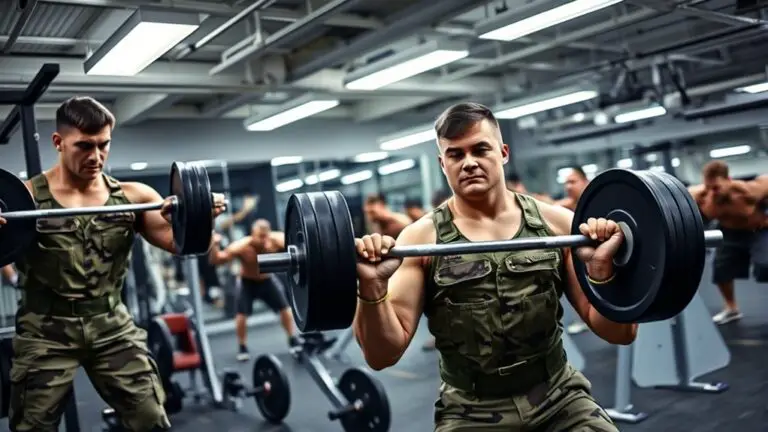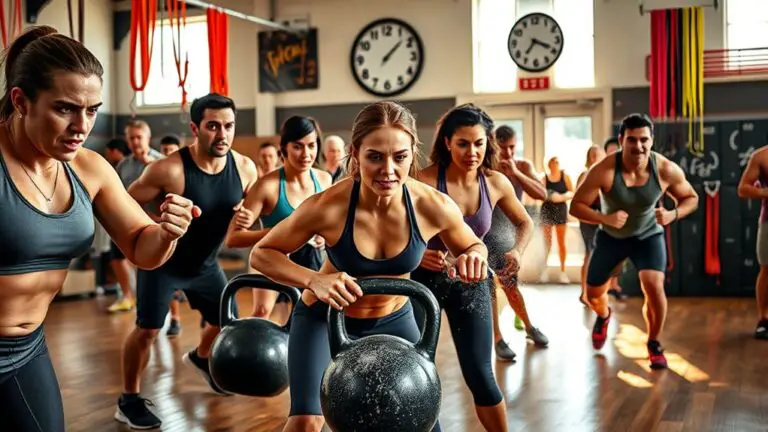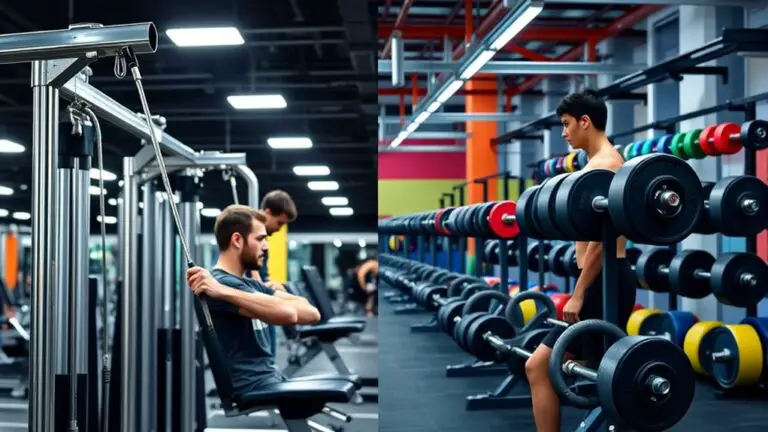How Powerlifters Train Differently From Bodybuilders
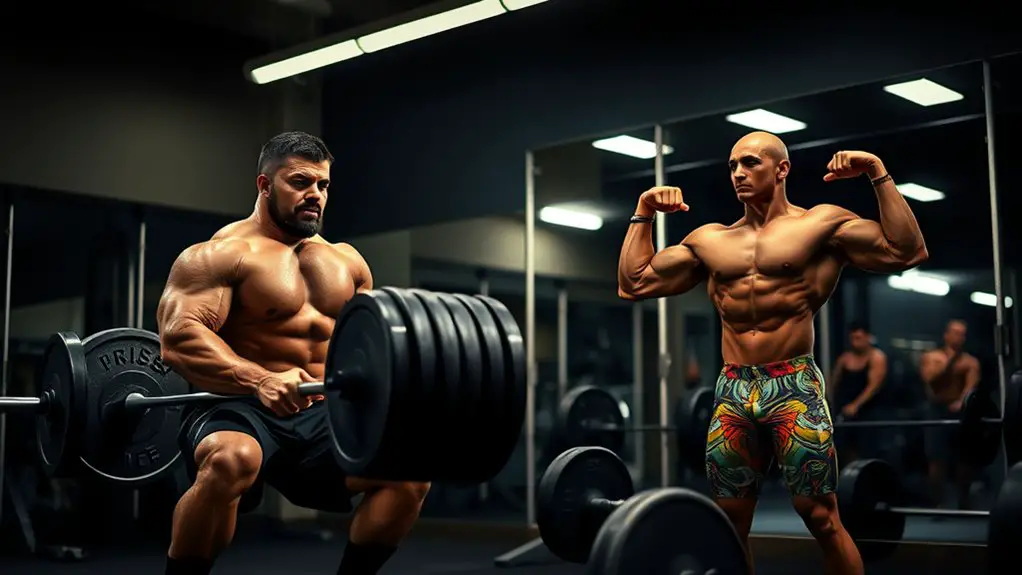
Powerlifters and bodybuilders train quite differently. Powerlifters focus on maximizing strength with low-rep, high-weight core lifts like squats, bench presses, and deadlifts. They prioritize safety and recovery. In contrast, bodybuilders aim for muscle size and aesthetics, using higher-rep workouts with diverse exercises targeting specific muscle groups. Their training is often higher in volume and intensity. Each approach has distinct nutritional needs and mindset strategies, which you’ll discover more about as you explore further.
Training Goals and Objectives
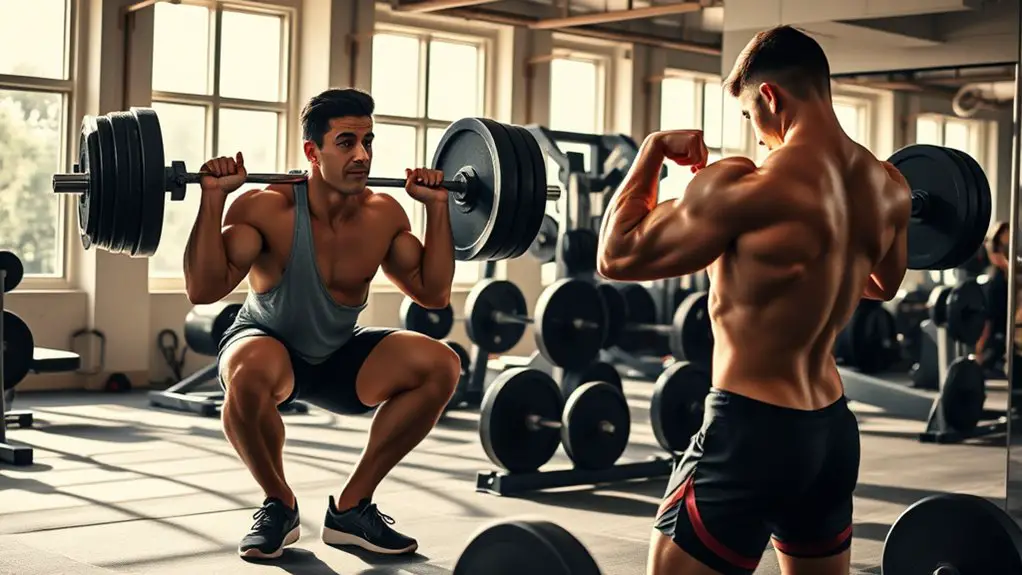
When it comes to training goals and objectives, understanding the distinct purposes behind powerlifting and bodybuilding is essential. If you’re aiming for strength, powerlifting focuses on maximizing your performance in three key lifts: the squat, bench press, and deadlift. You’ll prioritize low-rep, high-weight training, developing your overall power. On the other hand, bodybuilding emphasizes hypertrophy, which means building muscle size and aesthetics. You’ll often perform higher reps with moderate weights to sculpt your physique.
Choosing between these two paths can impact your training approach. If you’re more interested in performance, powerlifting may be your route. But if aesthetic appeal is your goal, bodybuilding will likely suit you better. Regardless of your choice, prioritize safety by using proper techniques and listening to your body. Understanding these differences will help you set realistic and safe training objectives aligned with your personal fitness aspirations.
Workout Structure and Volume
While both powerlifting and bodybuilding require a structured approach to training, their workout volumes and structures differ considerably. Powerlifters tend to focus on lower volume but higher intensity, prioritizing strength gains over muscle size. Their workout splits often emphasize heavy lifting on core lifts like the squat, bench press, and deadlift, with fewer accessory exercises. This allows for ample recovery time, which is essential for avoiding injuries.
In contrast, bodybuilders typically adopt higher volume training with more moderate intensity. They use various workout splits to target specific muscle groups multiple times a week, aiming for hypertrophy. This means they often include more sets and reps, pushing their muscles to fatigue for growth.
Understanding these differences can help you design a program that aligns with your goals while ensuring you prioritize safety and recovery. Ultimately, whether you’re lifting heavy or focusing on aesthetics, proper structure and volume are key to progress.
Exercise Selection and Technique
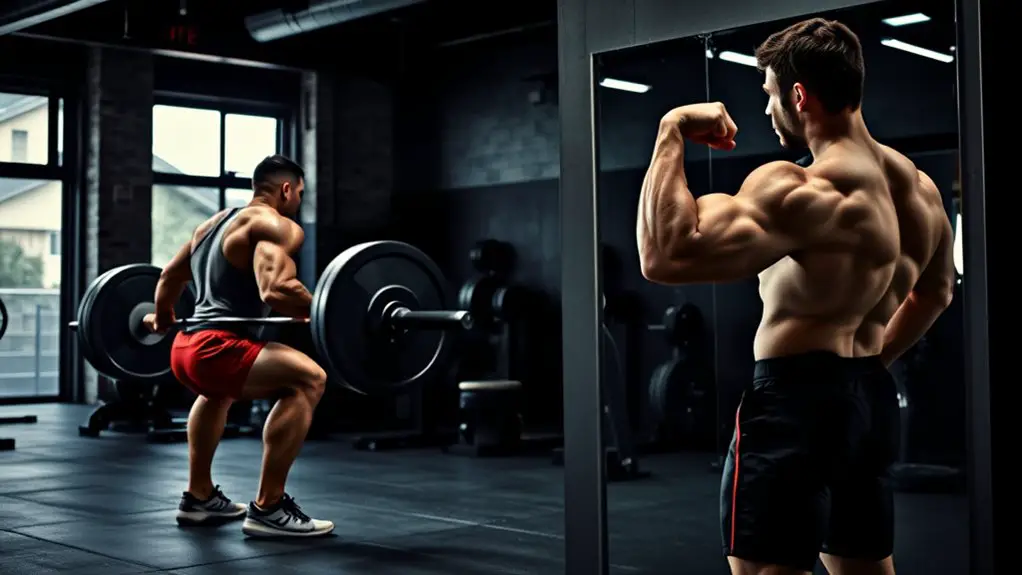
Although both powerlifters and bodybuilders aim to enhance their physical performance, their exercise selection and technique reflect their distinct goals. Powerlifters focus on a few core lifts—like the squat, bench press, and deadlift—prioritizing maximal strength. They emphasize technique to guarantee safety and efficiency, often using lower volume and higher intensity in their training.
In contrast, bodybuilders incorporate a greater exercise variety, targeting specific muscle groups to achieve hypertrophy. Their technique emphasizes form and controlled movements, which helps prevent injuries while maximizing muscle growth.
You’ll notice powerlifters often practice their lifts repeatedly to refine their technique, while bodybuilders may switch exercises regularly to stimulate different muscles. Ultimately, understanding these differences can help you tailor your training approach, whether you’re aiming for strength or size, while guaranteeing you stay safe and effective in your workouts.
Nutritional Approaches
Training goals markedly influence nutritional strategies for both powerlifters and bodybuilders. If you’re focused on building strength like a powerlifter, your macronutrient ratios will likely prioritize protein and carbohydrates to support heavy lifting and recovery. Ideally, you might aim for a higher protein intake, ensuring your muscles get the nourishment they need.
Conversely, if you’re leaning towards bodybuilding, your focus might shift to a balanced approach with more attention to overall body composition. You’ll often adjust your meal timing to optimize muscle growth and fat loss, eating smaller meals throughout the day to keep your metabolism active.
Regardless of your goal, it’s essential to maintain a well-rounded diet that meets your specific needs. Prioritizing whole foods and staying hydrated can make a significant difference in your performance and overall health. Always remember, it’s best to consult a registered dietitian to tailor a plan that’s safe and effective for you.
Recovery Strategies
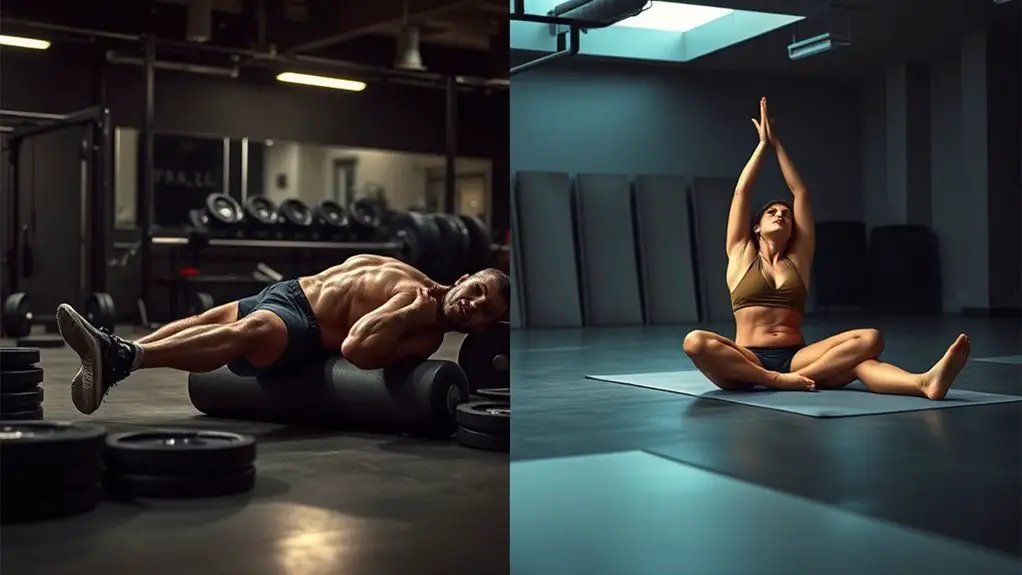
When it comes to recovery strategies, you need to contemplate various techniques that can enhance your performance. Active recovery, proper sleep, nutrition, and understanding deloading phases all play vital roles in your training success. Let’s explore how each of these elements can help you optimize your recovery.
Active Recovery Techniques
Active recovery techniques play an essential role in enhancing your overall performance and reducing the risk of injury. Incorporating these methods into your routine can help you recover faster and stay injury-free. Here are some effective strategies you should consider:
- Foam rolling: This helps release muscle tightness, increasing blood flow and flexibility.
- Active stretching: Gentle movements can improve your range of motion and reduce soreness.
- Low-intensity cardio: Activities like walking or cycling keep blood circulating without overexerting yourself.
Sleep and Nutrition
Sleep and nutrition are two critical components of recovery that can greatly enhance your performance in powerlifting and bodybuilding. Establishing consistent sleep patterns is essential; aim for 7-9 hours each night to allow your body to repair and grow stronger. Prioritize quality sleep by creating a calming bedtime routine and minimizing distractions.
On the nutrition front, pay attention to your dietary preferences. Powerlifters often focus on higher protein intake to support muscle recovery, while bodybuilders might emphasize balanced macros for aesthetic goals. Fueling your body with the right nutrients—like whole foods, healthy fats, and complex carbohydrates—can boost your energy levels and enhance recovery. Remember, proper sleep and nutrition aren’t just helpful; they’re essential for achieving your fitness goals safely.
Deloading Phases Explained
Although you may feel tempted to push through every workout without pause, incorporating deloading phases into your training routine is crucial for long-term progress and recovery. Deloading gives your body the chance to recover and adapt, preventing injuries and burnout.
Consider these deloading benefits:
- Improved Recovery: Your muscles and joints need time to heal.
- Enhanced Performance: Regular deloads can lead to better strength gains over time.
- Mental Refresh: A break can keep you motivated and focused.
Aim for a deloading frequency that suits your intensity—usually every 4-6 weeks or after intense training cycles. Prioritizing these phases will guarantee you stay safe and effective in your powerlifting journey.
Competition Preparation and Mindset
When you’re preparing for a competition, having a goal-oriented mentality is essential. It helps you focus on your strength progression and keeps you motivated throughout the process. With the right mindset, you can push through challenges and achieve your best performance.
Goal-Oriented Mentality
Whether you’re prepping for a powerlifting meet or a bodybuilding competition, having a goal-oriented mentality is essential to your success. This mindset can drive you to push through challenges while prioritizing safety during your training. Understanding the mindset differences between powerlifters and bodybuilders will help you sharpen your focus.
- Recognize your motivation factors to stay committed.
- Set specific, measurable goals for accountability.
- Cultivate a positive mental attitude to overcome obstacles.
Focus on Strength Progression
As you prepare for a competition, focusing on strength progression is essential for both powerlifters and bodybuilders alike. Unlike bodybuilders, who may prioritize aesthetics, powerlifters hone in on strength metrics to guarantee they’re lifting safely and effectively. This isn’t just about lifting heavier; it’s about consistent progression tracking. By monitoring your lifts, you can identify areas for improvement and adjust your training regimen accordingly. Incorporating incremental increases in weight while maintaining proper form helps prevent injuries and enhances your overall performance. Remember, your mindset should be centered on gradual gains rather than instant results. Embrace the journey, prioritize safety, and stay committed to your strength progression as you work towards your competition goals.
Frequently Asked Questions
How Do Powerlifters Choose Their Lifting Shoes?
When choosing your lifting shoes, it’s essential to take into account the shoe types that offer stability and support. Look for brands like Adidas, Nike, or Inov-8, which are known for their quality. You’ll want a shoe with a flat sole for ideal power transfer and a secure fit to prevent injury. Make sure to try on different styles to find what feels best for your foot, ensuring you’re safe while lifting heavy.
What Role Does Mental Focus Play in Powerlifting?
Did you know that nearly 75% of powerlifters attribute their success to mental focus? In powerlifting, mental visualization is vital; it helps you picture each lift, preparing your mind for the weight. A strong competition mindset keeps you calm and collected, reducing the risk of injury. By focusing on your mental game, you enhance performance and guarantee safety. Ultimately, honing your mental focus can be just as important as physical training.
Do Powerlifters Use Supplements Differently Than Bodybuilders?
When it comes to supplements, you’ll find that powerlifters often focus on specific supplement stacks tailored to support maximal strength and recovery. They usually prioritize protein powders, creatine, and essential amino acids. Your dietary preferences might lean towards whole foods, but powerlifters might incorporate more calorie-dense options to fuel intense workouts. It’s vital to ascertain any supplements you choose are safe and effective, so always consult with a healthcare professional before starting anything new.
How Do Powerlifters Assess Their Progress?
Did you know that powerlifters often aim to increase their lifts by 5-10% every few months? To assess your progress, you’ll want to focus on progress tracking through consistent strength benchmarks. Regularly testing your one-rep max will help you gauge improvements while ensuring you’re lifting safely. Keeping a detailed log of your lifts not only motivates you but also helps identify areas needing attention, ensuring you stay on the path to strength gains.
What Are Common Injuries in Powerlifting Versus Bodybuilding?
When it comes to common injuries, powerlifting often sees issues like lower back pain and shoulder injuries due to heavy lifting. In bodybuilding, you might encounter joint problems from repetitive motions. To minimize risks, focusing on proper form and using injury prevention strategies is essential. If you do get hurt, don’t hesitate to use rehab techniques like mobility work and strength training adjustments to aid recovery and get back to lifting safely.
